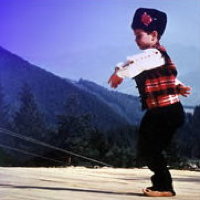
|
Folk Dance Federation of California, South, Inc.
|

|
CLICK IMAGE TO ENLARGE
Tips for Learning to Folk Dance
Here are some tips about how to enhance the process of learning international folk dancing.
Come early, come often. Research shows that what really counts is muscle memory — doing the same movements over and over again. How do you get to Carnegie Hall? Practice, practice, practice.
Pick five to ten dances that you really like — the ones where you say to yourself as it ends: "I liked this dance!" Go over to the program book and see what dance it was, or ask someone. Keep a list. Request "your" dances often (programmers LIKE requests). Get the music — play it in the car. When you can dance your dances while talking to a friend or partner, you've got it! it's time to pick the next ten dances.
Tune into the steps. Identify and work on some basic figures: grapevine, step-hop, step-together-step, pas-de-bas, lift-step, etc. Once you can recognize and do this dance "language," you can master any dance fairly quickly because you can recognize the sequences.
Line strategies for intermediate to advanced dances: Once a dance has started (while you're hanging back to see whether you know it or not) join in the middle. The first three to four spots in a dance line are where the "hotshots" will congregate to do extra variations. If you need to concentrate on steps or are unsure of the dance, the middle section is good. The end is okay, but you may feel "dragged" and may, without meaning to, drag the line.
Never hesitate to get into the line. The longest journey begins with a single step-hop. But be aware that on more complicated dances, the dance is more fun for everyone if you're able to move in the line of direction! One way to work on steps is to dance behind the line. Another is to pick a dance you really, really want to learn, and ask that it be taught.
Oh yes, and don't forget . . . come early, come often!
Tips for Programming a Folk Dance Evening
The programmer selects the dances that will be played during the course of an evening. Plan on ten or eleven dances per hour. Select dances that are widely known. Contrast dances (couple, circle, line). Use progressive dances and mixers to allow people to become better acquainted. Among the dances of the evening should be dances taught in the previous weeks.
Possibly use request board so that people can write down the dances they want to dance (columns divided into circle/line and couple). Generally, the programmer selects a dance from this list, usually alternating fast dances with slow ones, and couple dances with circle and line dances.
Tips for Selecting a Guest Teacher
Information on folk dance teachers is available through the web, folk dance magazines, and contacts with other clubs. Generally speaking, one should check with a person who has first-hand knowledge of a teacher and his or her reputation before making a commitment.
You should confirm the following details with the guest instructor in writing:
- The workshop format (number of sessions and hours per session)
- Type of dance styles (ethnicity, mixture of line/circle/couple)
- Honorarium, housing, and transportation
- Arrival and departure dates
- Photograph and biographical sketch for publicity purposes
- Permission to record summary of instruction
- Appearances for interviews on radio and newspapers
- Necessary equipment (computer, variable pitch CD or tape recorder, other machines, powerpoint, etc.)
- Availability of dance descriptions and music.
Tips for Teaching a Folk Dance
Some helpful reminders:
- Review the dance and music version ahead of time
- Practice "teaching" the steps aloud — even develop a cue card
- Check out the history behind the dance, where it's from, the correct pronunciation
- At the teaching session, let the class hear (and preferably see) the dance once
- Teach the dance in segments. Longer or more difficult dances should be taught and danced in segments in order to sustain interest
- Review, review, review
- Be patient, admit mistakes.
Tips for Selecting Facilities
Arrangements for facilities should be made as soon as any particular event has been confirmed. In selecting a facility, consideration should be given to these factors:
- Location and parking
- Dance area, kitchen facilities, seating
- Deposits, fees, clean-up requirements
- Bathrooms, dressing rooms
- Lighting, public address system, electrical outlets
- Availability of telephone
- Access prior to use (for pre-inspection and decorating).
Once an agreement with the owner or manager of a facility has been reached, a written confirmation of the terms (fees, time of use, access, clean-up, etc.) should be sent.
Tips for Arranging Publicity
Publicity is an important ingredient in any successful activity. Start early. Every medium has a deadline.
Posters should be distributed at least ten days in advance of the event. Obtain permission for posting.
Newspapers are usually willing to publish and radio stations are willing to air public service announcements, usually up to three days before the event. Whatever the medium, information should include a description of the event, dates, place, registration, fees, general schedule of events, and a contact for further information.
Used with permission.